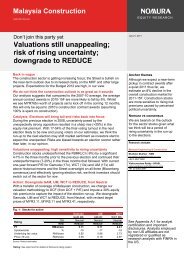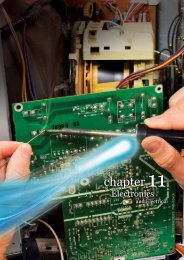Download PDF - ETP - Pemandu
Download PDF - ETP - Pemandu
Download PDF - ETP - Pemandu
Create successful ePaper yourself
Turn your PDF publications into a flip-book with our unique Google optimized e-Paper software.
EPP 10<br />
Strengthening Productivity<br />
of Paddy Farming in MADA<br />
With national paddy productivity increasing at 1.73 per cent since<br />
2005, a game-changing measure needs to be made to increase<br />
local rice production towards establishing long-term food security<br />
for Malaysia. This EPP aims to use the estate farming approach<br />
under a single management in the Muda granary area spanning<br />
Kedah and Perlis, which in turn should increase productivity from<br />
the current 4.71 metric tonne per hectare (MT/ha) to 8.0 MT/ha<br />
by 2020. This will be achieved by amalgamating 50,000 hectares of<br />
paddy fields by 2020. For 2011, the Muda Agricultural Development<br />
Authority (MADA) was expected to amalgamate 5,000 hectares of<br />
land and obtain approvals of approximately 2,500 farmers to lease<br />
their land for management under MADA.<br />
Achievements<br />
Preliminary work to kick-off this EPP included 50 briefings<br />
conducted by MADA to almost 4,224 farmers in the Muda<br />
area between December 2010 and July 2011. This project was<br />
eventually launched on 13 September 2011 by the MoA. MADA<br />
amalgamated 5,000 hectares of land involving 2,982 farmers<br />
from 27 Farmer’s Organization (Pertubuhan Peladang Kawasan).<br />
An organisational structure was created with involvement from<br />
the Farmer’s Organization, to conduct operations according<br />
to the planting and harvesting schedule set by MADA, which<br />
allows optimal use of mechanisation in paddy farming. Planting<br />
commenced in October 2011 and its preliminary harvest in<br />
January 2012 is expected to yield between six to eight MT.<br />
EPP 11<br />
The project is slated to commence in 2012 as an expansion of EPP<br />
10’s success. The estate-farming model used in the Muda area<br />
will be replicated in other granaries under this project. The aim is<br />
to increase paddy productivity in other areas, thereby boosting<br />
Malaysia’s self-sufficiency in rice to 85 per cent.<br />
Achievements<br />
Strengthening Productivity<br />
of Paddy Farming in Other Granaries<br />
A pilot project was planned in Batang Lupar, Sarawak to increase<br />
the yield and introduce modern paddy farming in the area.<br />
The project was started on 50 hectares of traditional paddy<br />
fields in Block C, Bijat-Stumbin. Padiberas Nasional Berhad<br />
(BERNAS), Ministry of Modernization Agriculture Sarawak and<br />
the Department of Agriculture Sarawak held numerous briefings<br />
with the long house communities in the area since April 2011 to<br />
obtain the people’s approval for the amalgamation of paddy fields<br />
Moving Forward<br />
MADA is undertaking the upgrading and construction of a<br />
tertiary system in the irrigation infrastructure for a more efficient<br />
water management in the Muda area. This infrastructure will be<br />
carried out in phases, from 2012 up to 2020. Depending on the<br />
success of the project this year, another 5,000 hectares have been<br />
targeted for further amalgamation in 2012. MADA is collaborating<br />
with BERNAS, an organisation responsible for the domestic rice<br />
industry in Malaysia, to form a special-purpose vehicle which will<br />
manage the paddy farming operations in the Muda granary.<br />
Ploughing activities by Bridge (Wilayah II)<br />
NKEA: Agriculture EPP 9 – EPP 11<br />
under BERNAS’ management. Responses by the Sarawak locals<br />
were favourable, with full support garnered from the farmers<br />
to participate in the project. The result was a contiguous block<br />
of 77.73 hectares of fields amalgamated with the participation<br />
of 144 families from 11 long houses. Modern paddy planting<br />
commenced in September 2011 at Batang Lupar, Sarawak with<br />
direct participation from the farmers.<br />
In April 2011, the Department of Agriculture Sarawak proposed to<br />
transform Bario, Sarawak, from its traditional subsistence farming<br />
model to a commercial-scale estate farm. With Bario Ceria Sdn<br />
Bhd as the anchor company, 30 hectares of virgin paddy fields<br />
have been mechanised and operated on using the estate-farming<br />
model in September 2011. The yield per hectare previously stood<br />
between 0.8 to 1 MT/ha. The farmers are currently harvesting<br />
approximately 2.5 MT/ha.<br />
(more on next page)<br />
193








